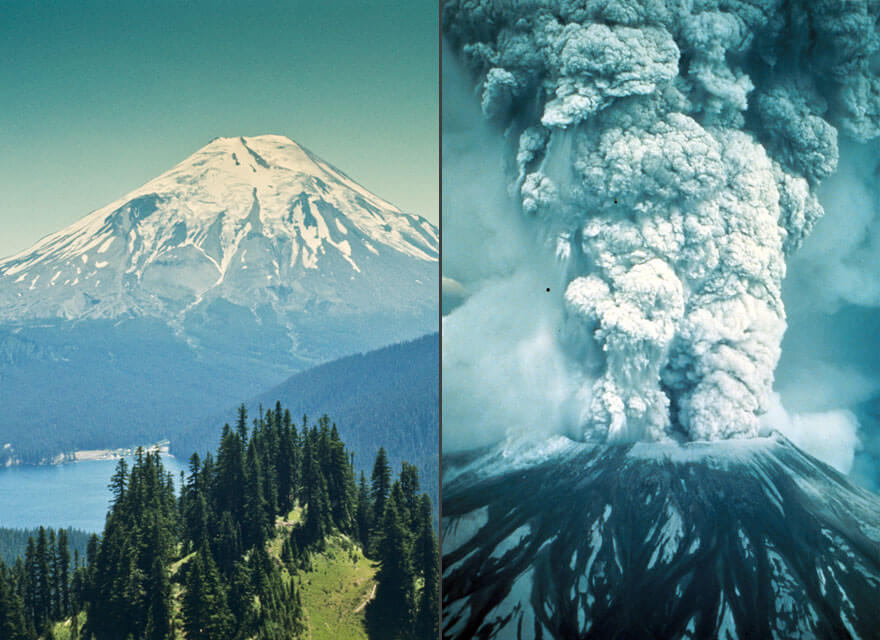Mount St. Helens, Cascade Range, before (left) and after the 1980 explosion
Forty years ago, Mount St. Helens in southwestern Washington State erupted in an epic explosion of ash, gas, and rock. The May 18, 1980, lateral blast was the most destructive volcanic eruption ever seen in the continental United States. It killed 57 people and thousands of animals; destroyed tens of thousands of acres of forest over a 200-square-mile area; flattened 200 homes; damaged 185 miles of highway; and caused more than $1 billion in damage, mainly to the timber industry.
Before the spring of 1980, the volcano had been dormant since 1857. What changed? According to Ben Andrews, the director of the Smithsonian Institution’s Global Volcanism Program, between March and May in 1980, the Mount St. Helens volcano’s stored magma began to rise—from about three to five miles below the surface. Pressure from rising magma caused a growing bulge on the mountain. “Instead of [the magma] coming out and sitting on the surface,” Andrews said, “it made a great big bulge just beneath the north side of the mountain.” In the early morning of May 18, a 5.1-magnitude earthquake rocked the mountain. The quake triggered the largest landslide in Earth’s recorded history and led to an explosion that thrust a plume of ash and rock about 15 miles into the stratosphere at a velocity of 300 miles per hour. The ash even left Spokane, Washington, about 250 miles away, in darkness. The explosion blew more than 1,300 feet off Mount St. Helens’s previous 9,677-foot peak. Andrews likened the blast to “taking a champagne bottle and cutting off the top with a sword.”
Forty years later, U.S. scientists continue to study the eruption’s cause and effects. Today, researchers from the U.S. Geological Survey, academic institutions, and other government agencies are part of the Community Network for Volcanic Eruption Response (CONVERSE), a program to detect volcanic unrest and prevent volcanic disasters. Meanwhile, Mount St. Helens National Park offers people a chance to study volcanoes and learn how ecosystems respond to cataclysmic disturbances. The park’s visitor center features a timeline of events leading up to the 1980 volcanic blast; a large, step-in model of the volcano; and a live feed of current Mount St. Helens volcano seismic data. At the nearby Johnston Ridge Observatory, visitors can view the now horseshoe-like crater, lava dome, animals and plants that have recolonized the blast zone, and lakes that formed as a result of the eruption. Will the volcano awaken again? Time will tell.
Image credits: (©JeffGoulden/E+/Getty Images (left); U.S. Geological Survey (right)
Related Links:
- 40 Years after Mount St. Helens, Scientists Make Tiny Eruptions to Study Volcanoes
Account of the state of volcano research since the Mount St. Helens eruption.
(Source: Smithsonian Institution, May 17, 2020) - How Volcanic Is the United States?
Scientists list the most dangerous volcanos in the country.
(Source: National Geographic, October 26, 2018) - Ring of Fire
Learn about the belt of earthquake sites and volcanoes that sit on the rim of the Pacific Ocean.
(Source: Science News for Students, April 20, 2020) - Volcano Myths
Why ancient myths about volcanoes are often true.
(Source: BBC, March 18, 2015) - Mauna Kea’s Quakes Might Be Caused by Shifting Gas
The Hawaiian volcano has been rumbling regularly for years, but experts say not to worry.
(Source: Smithsonian Magazine, May 26, 2020)




